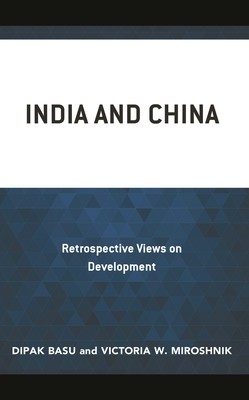
- We will send in 10–14 business days.
- Author: Dipak Basu
- Publisher: Lexington Books
- ISBN-10: 1666921920
- ISBN-13: 9781666921922
- Format: 15.2 x 22.9 x 1.9 cm, hardcover
- Language: English
- SAVE -10% with code: EXTRA
Reviews
Description
A regular feature in almost publication has been a comparison of India's slow economic growth and, until recently, China's rapid progress. Yet, in 1988, both countries had similar living standards. As things stand, it is undoubtedly a tale of two countries and two systems. Supporters of India can point to the democratic nature of the country's development while ignoring the slow pace of change. China's supporters point to exceptional poverty reduction, urbanization, and infrastructure developments while ignoring the social, religious, and environmental costs these efforts have created. However, popular media has ignored the fact the individual starting points of the two nations, a gap which this book fills. This study examines how China's economic reforms was initiated with Deng Xiaoping's fang-shou ('letting go' and 'tightening up') efforts between 1978 and 1989. However, until 1989 China had nothing much to demonstrate compare with India. Both countries had similar per head national income but India was technologically much superior to China. The reforms in China then accelerated in a sustained manner--be it the Family Responsibility System that transformed agriculture, the opening up of the industrial sector for the growth of local enterprises and foreign investments, or the substantial effort to make state-owned enterprises more efficient.
EXTRA 10 % discount with code: EXTRA
The promotion ends in 20d.16:41:02
The discount code is valid when purchasing from 10 €. Discounts do not stack.
- Author: Dipak Basu
- Publisher: Lexington Books
- ISBN-10: 1666921920
- ISBN-13: 9781666921922
- Format: 15.2 x 22.9 x 1.9 cm, hardcover
- Language: English English
A regular feature in almost publication has been a comparison of India's slow economic growth and, until recently, China's rapid progress. Yet, in 1988, both countries had similar living standards. As things stand, it is undoubtedly a tale of two countries and two systems. Supporters of India can point to the democratic nature of the country's development while ignoring the slow pace of change. China's supporters point to exceptional poverty reduction, urbanization, and infrastructure developments while ignoring the social, religious, and environmental costs these efforts have created. However, popular media has ignored the fact the individual starting points of the two nations, a gap which this book fills. This study examines how China's economic reforms was initiated with Deng Xiaoping's fang-shou ('letting go' and 'tightening up') efforts between 1978 and 1989. However, until 1989 China had nothing much to demonstrate compare with India. Both countries had similar per head national income but India was technologically much superior to China. The reforms in China then accelerated in a sustained manner--be it the Family Responsibility System that transformed agriculture, the opening up of the industrial sector for the growth of local enterprises and foreign investments, or the substantial effort to make state-owned enterprises more efficient.


Reviews